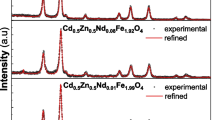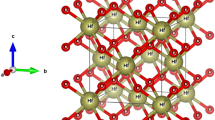Abstract
The AC conductivity of the LiCaPO4 compound has been measured in the temperature range 634–755 K and the frequency range 300 Hz–5 MHz. The impedance data were fitted to an equivalent circuit consisting of series combination of grains, grains boundary, and electrode elements. Dielectric data were analyzed using complex electrical modulus M* at various temperatures. The modulus plots are characterized by the presence of two relaxation peaks thermally activated. The activation energies obtained from the analysis of M″ (0.90 eV) and conductivity data (0.94 eV) are very close, revealing an ionic hopping mechanism.












Similar content being viewed by others
References
Mercier M, Gareyte J, Bertaut EF (1967) C R Acad Sci Paris B 264:979
Bertaut EF, Mercier M (1971) Mater Res Bull 6:907–921
Rivera JP, Schmid H (1994) Ferroelectrics 161:91
Rivera JP (1994) Ferroelectrics 161:147
Wolfenstine J (2006) J Power Sources 158:1431
Phadhi K, Nanjundaswamy KS, Goodenough JB (1997) J Electrochem Soc 144:1188
Yamada A, Hosoya M, Chung S-C, Kudo Y, Hinokuma K, Liu K-Y, Nishi Y (2003) J Power Sources 119:232
Okada S, Sawa S, Egashira M, Yamaki J, Tabuchi M, Kageyama H, Konishi T, Yoshino FA (2001) J Power Sources 97:430
Loris JM, Perez-Vicente C, Tirado JL (2002) Electrochem Solid State Lett 5:A234
Murugan AV, Murallganth T, Ferrelra PJ, Manthlram A (2009) Inorg Chem 48:946
Santoro RP, Segal DJ, Newnham RE (1966) J Phys Chem Solids 27:1192
Newnham RE (1975) Structure–Property Relations. Springer, Berlin
C Julien, GA Nazri (1994) Solid state batteries, materials design and optimization, Klumer, Boston
W Weppner, Julien, Z Stoynov (Eds.) (2000) Materials for Lithium-Ion Batteries, NATO-ASI Series, vol. Ser. 3, Kluwer, Dordrecht 413
Goodenough JB, Hong HYP, Kafalas JA (1976) Mater Res Bull 11:203
Manthiram A, Goodenough JB (1987) J Solid State Chem 71:349
K Rissouli (1996) Thesis, University of Chouaib Doukkali, El-Jadida, Morocco
Rissouli K, Benkhouja K, Bettach M, Sadel A, Zahir M, Derory A, Drillon M (1998) Ann Chim Sci Mat 23:85
Rissouli K, Benkhouja K, Ramos-Barrado JR, Julien C (2003) Mater Sci Eng B98:185
Gofii A, Lezama L, Barberis GE, Pizarro JL, Arriortua MI, Rojo T (1996) J Magn Magn Mater I64:351
Thilo E (1941) Naturwissenschaften 29:239–239
More SD, Meshram MN, Wankhede SP, Muthal PL, Dhopte SM, Moharil SV (2011) Phys B 406:1178–1181
Lightfoot P, Pienkowski M, Brucea P, Abrahamd I (1991) J Mater Chem 1(6):1061–1063
Delacourt C, Wurm C, Laffont L, Leriche JB, Masquelier C (2006) Solid State Ionics 177:333
Ram M (2010) Phys B 405:602
Papathanassiou AN, Grammatikakis J (1996) Phys Rev B 53:16252–16257
Papathanassiou AN, Grammatikakis J (1997) Phys Rev B 56:8590–8598
Papathanassiou AN, Grammatikakis J (2000) J Phys Chem Solids 61:1633–1638
Subramanian MA, Subramanian R, Clearfield A (1986) Solid State Ionics 18:562
Chopra S, Sharma S, Goel TC, Mendiratta RG (2003) Solid State Commun 127:299
Macedo PB, Mognihan CT, Bose R (1972) Phys Chem Glasses 13:171
Ganguli M, Harish Bhat M, Rao KJ (1999) Phys Chem Glasses 40:297
Lanfredi S, Saia PS, Lebullenger R, Hernandes AC (2002) Solid State Ionics 146:329
Ghosh S, Ghosh A (2002) Solid State Ionics 149:67
Louati B, Guidara K, Gargouri M (2009) J Alloys Compd 472:347
Gomes D, Algeria A (2001) J Non Cryst Solids 287:246
Havriliak S, Negami S (1967) Polymer 8:161
KL Ngain, GB Wrigh (1998) J. Non-Cryst Solids 235
Alvarez F, Alegria A, Colmenero J (1993) J Phys Rev B 47:125
Alvarez F, Alegria A, Colmenero J (1991) J Phys Rev B 44:7306
Alegria A, Echevarria E, Goiyiandia L, Telleria I, Colmenero J (1995) Macromolecules 28:1516
Author information
Authors and Affiliations
Corresponding author
Rights and permissions
About this article
Cite this article
Louati, B., Guidara, K. Dielectric relaxation and ionic conductivity studies of LiCaPO4 . Ionics 17, 633–640 (2011). https://doi.org/10.1007/s11581-011-0555-1
Received:
Revised:
Accepted:
Published:
Issue Date:
DOI: https://doi.org/10.1007/s11581-011-0555-1




